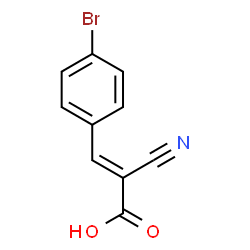3-(4-bromophenyl)-2-cyanoacrylic acid

3-(4-bromophenyl)-2-cyanoacrylic acid structure
|
Common Name | 3-(4-bromophenyl)-2-cyanoacrylic acid | ||
|---|---|---|---|---|
| CAS Number | 339548-64-0 | Molecular Weight | 252.064 | |
| Density | 1.7±0.1 g/cm3 | Boiling Point | 395.4±32.0 °C at 760 mmHg | |
| Molecular Formula | C10H6BrNO2 | Melting Point | N/A | |
| MSDS | Chinese USA | Flash Point | 192.9±25.1 °C | |
| Symbol |

GHS07 |
Signal Word | Warning | |
|
4-Chloro-alpha-cyanocinnamic acid is an advanced, rationally designed MALDI matrix.
Proc. Natl. Acad. Sci. U. S. A. 105(34) , 12200-5, (2008) Matrix-assisted laser desorption ionization (MALDI) has become an enabling technology for the fields of protein mass spectrometry (MS) and proteomics. Despite its widespread use, for example, in protein identification via peptide mass fingerprinting, a compre... |
|
|
Ion yields in UV-MALDI mass spectrometry as a function of excitation laser wavelength and optical and physico-chemical properties of classical and halogen-substituted MALDI matrixes.
Anal. Chem. 84(15) , 6567-76, (2012) The laser wavelength constitutes a key parameter in ultraviolet-matrix-assisted laser desorption ionization-mass spectrometry (UV-MALDI-MS). Optimal analytical results are only achieved at laser wavelengths that correspond to a high optical absorption of the ... |
|
|
The new matrix 4-chloro-alpha-cyanocinnamic acid allows the detection of phosphatidylethanolamine chloramines by MALDI-TOF mass spectrometry.
J. Am. Soc. Mass Spectrom. 20(5) , 867-74, (2009) Phosphatidylethanolamines (PEs) are abundant lipid constituents of the cellular membrane. The amino group of PEs exhibits high reactivity with hypochlorous acid that is generated under inflammatory conditions in vivo. The analysis of the resulting PE mono- an... |
|
|
Color matters--material ejection and ion yields in UV-MALDI mass spectrometry as a function of laser wavelength and laser fluence.
J. Am. Soc. Mass Spectrom. 24(10) , 1477-88, (2013) The success of matrix-assisted laser desorption/ionization mass spectrometry (MALDI-MS) as a widely employed analytical tool in the biomolecular sciences builds strongly on an effective laser-material interaction that is resulting in a soft co-desorption and ... |
|
|
Comparison between the matrices alpha-cyano-4-hydroxycinnamic acid and 4-chloro-alpha-cyanocinnamic acid for trypsin, chymotrypsin, and pepsin digestions by MALDI-TOF mass spectrometry.
J. Proteome Res. 8(7) , 3588-97, (2009) The performance of the recently developed 4-chloro-alpha-cyanocinnamic acid (Cl-CCA) matrix-assisted laser desorption ionization mass spectrometry (MALDI MS) matrix was investigated in comparison to the most widely used matrix alpha-cyano-4-hydroxycinnamic ac... |
|
|
Matching the laser wavelength to the absorption properties of matrices increases the ion yield in UV-MALDI mass spectrometry.
Anal. Bioanal. Chem 405(22) , 6925-32, (2013) A high analytical sensitivity in ultraviolet matrix-assisted laser desorption ionization mass spectrometry (MALDI-MS) is only achieved if the laser wavelength corresponds to a high optical absorption of the matrix. Laser fluence and the physicochemical proper... |
|
|
Significant sensitivity improvements by matrix optimization: a MALDI-TOF mass spectrometric study of lipids from hen egg yolk.
Chem. Phys. Lipids 163(6) , 552-60, (2010) Due to its sensitivity, the tolerance of impurities and the simplicity of performance, matrix-assisted laser desorption and ionization time-of-flight (MALDI-TOF) mass spectrometry (MS) is increasingly used to analyze lipids from biological sources. Although i... |
|
|
Peptide mass fingerprinting after less specific in-gel proteolysis using MALDI-LTQ-Orbitrap and 4-chloro-alpha-cyanocinnamic acid.
J. Proteome Res. 9(5) , 2619-29, (2010) Peptide Mass Fingerprinting (PMF) of tryptically in-gel digested samples is a well-established protein identification technique for MALDI mass spectrometry but an in-depth PMF evaluation for in-gel digestions of less specific enzymes is still missing. This st... |
|
|
Introduction of 4-chloro-alpha-cyanocinnamic acid liquid matrices for high sensitivity UV-MALDI MS.
J. Proteome Res. 9(4) , 1931-40, (2010) Matrix-assisted laser desorption/ionization (MALDI) is a key ionization technique in mass spectrometry (MS) for the analysis of labile macromolecules. An important area of study and improvements in relation to MALDI and its application in high-sensitivity MS ... |